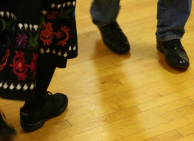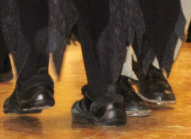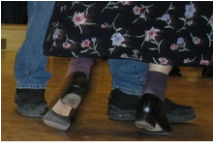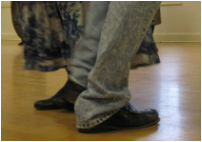|
Remote Dance Lesson for 5/4/2020
Hello dance friends ! Well, I hope you have had success in your search for that sometimes-elusive beat in our music. It’s a good tool to have and work with. Assuming you’ve found it let’s put it in play. With the advent of widely available social media we have access to videos of some of the best teachers from Scandinavian countries. These are not a substitute for teaching; they are for reviewing only. But that doesn’t make them less valuable for our purpose. Each of us have a preferred method of learning, and one can often learn from watching as well as from participating. And through Youtube you can view them over and over if you like, pause, rewind, take note of the foot work, the embrace, the body positions and movements. There are several good teachers, but the degree of skill and expertise vary considerably with knowledge, experience and training. I will identify those I’m familiar with and whose skill is widely acclaimed. I will attach a link to one or another with my memo(s). Concurrent with those I will offer suggestions on what to watch for. For this round, let’s look at a straightforward dance that we know, Bingsjo polska. Here is a link to two very good videos of the same dance taught by Leif and Margareta Virtanen https://www.youtube.com/watch?v=EAbxozKii_4 https://www.youtube.com/watch?v=JJ11gIwxf3s One is simply a brief demo of the dance while the other is a longer, more detailed instructional with breakdown for both men and women. Notice how smoothly these two interact in the turns. Observe how the body movement is up and down rather than side to side. Notice also that their heads are turned towards each other throughout the turning portion of dance. A wayward head can affect the balance between you. If you watch closely you will see that during the entire dance their bodies are balanced over their feet. That may seem like an obvious note, yet it is easy to make the mistake of letting your feet lead your torso. If anything, your upper body should lead your lower half. This is most noticeable in the forsteg (first step). Look closely at the bend in the knees. It is slight but definite. This characteristic distinguishes the dance from merely walking and contributes to the pleasure of the dance. You can practice this anywhere, anytime.. Note the difference between walking with locked and unlocked knees. A dancer would do well to practice knees bent until it becomes second nature and you don’t have to think about it anymore. And one last quick point about the turning: MEN'S TURN is routinely used in military format to turn the body without lifting your feet (torso leads). Right heel and left ball on beat three. WOMEN'S TURN: Beat 3 is on the ball of the left foot. Remote Dance Lesson for 6/10/2020
Hello again dance friends, Is that a turnaround I see on the horizon? One can hope. Meanwhile, let’s consider alternatives while we’re waiting. I’m hoping you are all maintaining some sort of physical activity to keep yourself limber and ready to get involved once we restart our weekly dancing. It seems reasonable to believe that there is both a physical and mental aspect to that maintenance program. Here's my thought on those: PHYSICALLY: In addition to the mere joy of dancing, there are also health benefits to consider, And we’d be hard pressed to try to resume our former level of activity without being prepared. Dancing is aerobic, after all, and it gets your heart pumping while working other muscles in your legs and butt, increases your flexibility, improves your balance and your coordination. It can also create harmony in your movement. So be sure to get some walking and stretching into your daily routine. Remember, this is meant to be fun; not a chore or something to get worked up about. Dancing is also helpful in lowering your blood pressure, not raise it, so don’t stress over it. MENTALLY: It’s important that you find that beat that you need so you can move your feet or shift your body weight at the moment necessary to execute a turn. You can do yourself a favor by listening to a tune enough times that you can feel it move you naturally. Let it into your head and try to flow with it. You’ll find it easy to tap your foot to the beat, but you may soon find your entire body – your head, your shoulders, your hips -- moving in synch with that foot, however subtle. With little effort a person can dance in their head. (No kidding.) This is something easy you can do at home to maintain your sense of rhythm. I am including a link to another Swedish dance and tune for your viewing pleasure .(And a second clip just for fun.) I’ll skip the comments this time. If you watch closely you will see those basic steps and distinguish them from the flourishes that come with experience and practice. Until again, be well. ~ Allen https://www.youtube.com/watch?v=WB2R1uR2hN4 https://www.youtube.com/watch?v=wiB24TtmdWs |




